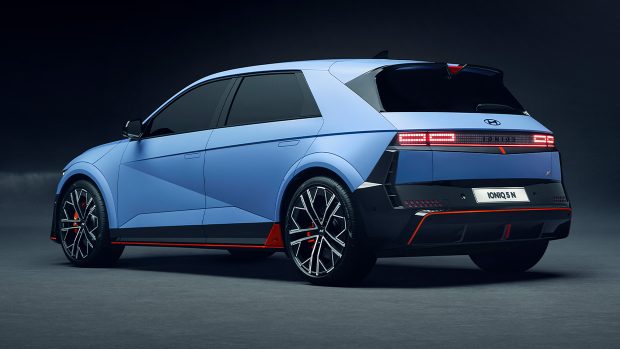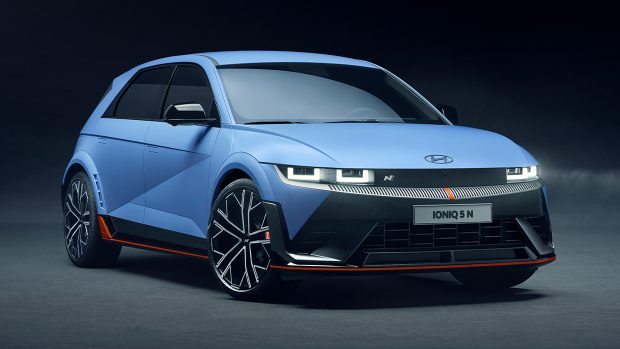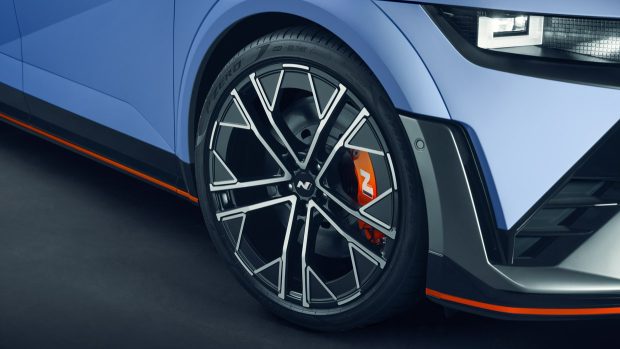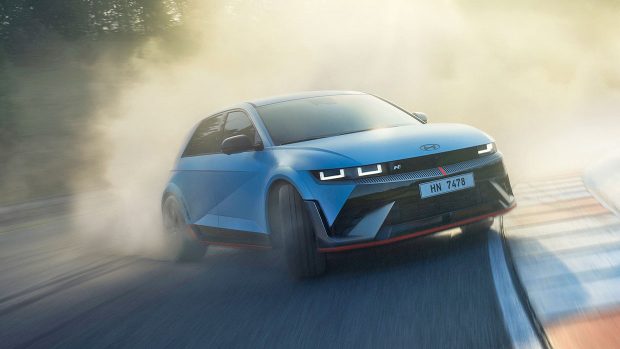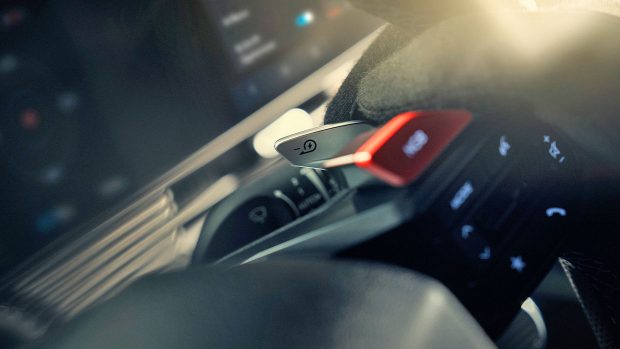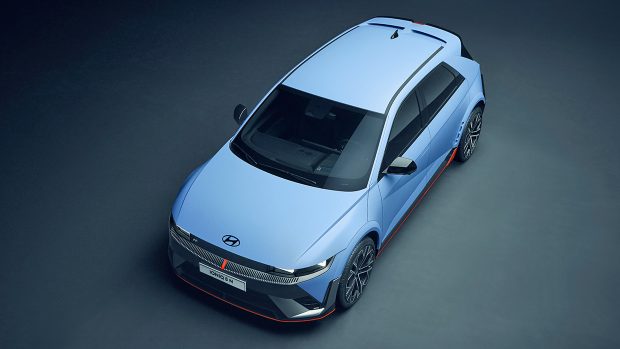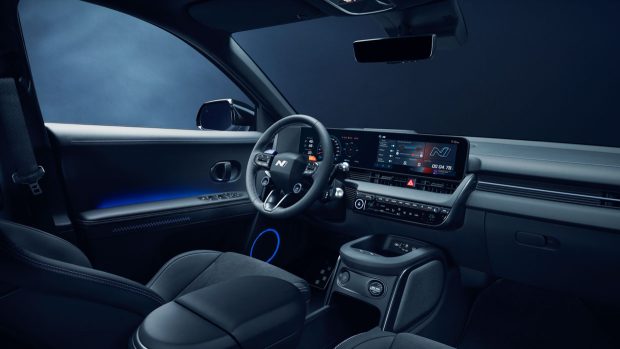-
Car Reviews
- All reviews
- Midsize SUVs
- Small cars
- Utes
- Small SUVs
- Large SUVs
- Large cars
- Sports SUVs
- Sports cars
- Vans
Latest reviews
- Car News
-
Car Comparisons
Latest comparisons
- Chasing Deals
The first N car to go all-electric has gone all-out, with the Ioniq 5 N undergoing a litany of major and incremental upgrades to earn the performance badge
Hyundai has unveiled the highly anticipated Ioniq 5 N and confirmed that it will be going on sale in Australia in the first half of 2024.
Packing more powerful motors front and rear providing up to 478kW and 770Nm, a 50mm wider stance and the biggest brakes ever fitted to a Hyundai, the Korean brand promises the Ioniq 5 N will be a well-rounded tool both on the track and on a back road.
While pricing details are still a long way off, the Ioniq 5 is likely to compete with a growing number of performance EVs including the Kia EV6 GT ($99,590 before on-roads) and Tesla Model 3 Performance ($83,400). We’ve created a separate article comparing all three cars spec-for-spec.
The high-performance EV is promised to be the first of many from the Korean brand, with a production version of the RN22e concept based on the Ioniq 6 the next logical step.
However, Hyundai vice president, N brand and motorsport Till Wartenberg, also expressed interest in bringing the N Vision 74 concept to production at the reveal, which you can read about in full in our separate article.
The Ioniq 5 N is paired with a set of dual motors capable of spinning at up to 21,000 RPM, consisting of a 166kW front and 282kW rear motor, providing a baseline output of 448kW and 740Nm.
Hyundai’s ‘N Grin Boost’, a variant of the N Grin Shift available on its petrol-powered models, ups this output temporarily to 478kW and 770Nm for 10 seconds – upping the power distribution to 175kW front and 303kW rear with a split of 36.4 and 63.6 percent.
In this mode, the Ioniq 5 N can accelerate from 0-100km/h in 3.4 seconds.
It seems logical that the most powerful Hyundai ever made would also have the largest brakes, with the Ioniq 5 N wearing four-piston monoblock callipers at the front biting into 400mm discs, while the rear uses a single-piston and 360mm disc setup.
The question of weight was left unanswered by Hyundai when questioned by the media but it’s expected to be a touch heavier than the current dual-motor Ioniq 5 in Epiq guise (2125 kg) thanks to technical differences, as well as its fatter 275mm Pirelli P-Zero tyres and the 50mm wider bodywork to accommodate them.
The Ioniq 5 N also sits 20mm lower and is 80mm longer than its non-N variants, with the latter largely owing to the diffuser at the rear. The rims stretch a massive 21 inches.
Hyundai has also increased the battery size to 84kWh, with the Australian arm of the Korean brand currently unable to confirm if this is of a usable or gross capacity. The new battery is paired with a two-stage inverter. Driving range has not yet been disclosed.
Despite the increase in size, Hyundai says the Ioniq 5 N is still capable of recharging from 10 to 80 percent in 18 minutes thanks to DC charging speeds of up to 350kW.
At the reveal, former lead engineer of the Ford Focus RS and current head of research and development in Hyundai Motor Group in Europe Tyrone Johnson said “the goal of this project was not to deliver a car that was fast in a straight line but believe me this car is fast”.
The Ioniq 5 N benefits from a raft of key enhancements dedicated to pushing the dynamic EV envelope.
Structurally, there are an additional 42 welding points on the chassis, 2.1 metres of adhesive and reinforcement to the motor mounting points to increase body rigidity.
The front and rear subframes have also been enhanced for increased lateral rigidity, while integrated drive shafts were fitted to trim unsprung weight.
An electronic limited-slip differential has also been fitted at the rear axle, with the system also working in tandem with motor controls and torque vectoring abilities.
Hyundai has also fitted electrically controlled adaptive dampers to improve handling and provide a better balance both on and off track.
The steering rack is also unique to the Ioniq 5 N, with engineers implementing a system with a faster ratio and a tuning said to yield improvements in response and feedback.
Among the litany of driving modes is “N Drift Optimiser”, which helps maintain a tail slide based on the inputs of the driver.
Perhaps more interesting is the fact that the Ioniq 5 N works to simulate a ‘clutch kick’ function of a manual rear-driven combustion car, allowing drivers to break into the slide suddenly and more easily.
Alongside the hydraulic system, engineers have turned up the regenerative braking ability up to 0.6G of decelerative force.
Hyundai says by utilising the regenerative brakes more on track, the Ioniq 5 is able to counter its “relative heaviness” and reduce the chances of brake fade.
It also claims the transition between regenerative braking and the hydraulic system is imperceptible to the driver, with this function also able to work in tandem with ABS.
And unlike some other EVs, the throttle and brakes can be operated independently – crucial for left-foot braking.
Electric vehicles have developed a bit of a reputation for tearing through battery power very quickly in hard driving conditions and Hyundai has done its best to address this with multiple driving models and battery preconditioning.
The Ioniq 5 N comes fitted with battery conditioning for two fundamental settings. The first is Drag Mode that prepares the pack for a short burst of power by increasing the temperature of the pack. Meanwhile, the second setting is a Track Mode, which lowers the temperature to preserve longevity.
Similar control is seen within ‘N Race’ mode, with ‘Sprint’ working to keep temperatures down for fast lap times while ‘Endurance’ preserves the maximum driving range by reducing the maximum power output to keep the battery cooler for longer stints.
For those craving some traditional N behaviour, Hyundai has also added N Active sound that projects the sound of a combustion engine, a fighter jet or an EV. There’s also an ‘N e-shift’ setting that simulates the behaviour of an eight-speed dual-clutch automatic transmission.
As previously stated, the exterior dimensions of the Ioniq 5 N has grown and the design itself has changed with a more aggressive design including the bulging wheel arches, rally-style spoiler, a large diffuser and additional cooling vents for the battery.
While specifications are still yet to be confirmed for Australia, the Ioniq 5 N has been revealed with a unique interior offered in a combination of either cloth and leather, or in a mix of recycled synthetic Alcantara and leather.
Two bucket seats sit up front with the driver sitting lower than in the regular models, with the interior also featuring a unique steering wheel design.
Latest news
About Chasing cars
Chasing Cars reviews are 100% independent.
Because we are powered by Budget Direct Insurance, we don’t receive advertising or sales revenue from car manufacturers.
We’re truly independent – giving you Australia’s best car reviews.
